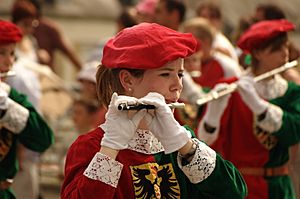Piccolo facts for kids
| Woodwind instrument | |
|---|---|
| Classification | |
| Hornbostel–Sachs classification | 421.121.12-71 (Flute-like aerophone with keys) |
| Playing range | |
|
The piccolo sounds one octave higher than written. |
|
| Related instruments | |
The piccolo is a small and mighty flute. It plays notes that are one octave (eight notes) higher than a regular flute. This makes it the highest-sounding instrument you'll find in an orchestra! Sometimes, its bright sound can even remind you of a bird's call.
What is a Piccolo?
The word "piccolo" means "small" in Italian. This instrument looks a lot like a regular flute, but it's much shorter. Because it's so small, it makes very high-pitched sounds.
When a composer writes music for the piccolo, the notes look lower on the page than they actually sound. This is because the piccolo sounds one octave higher than what is written. It's a bit like a secret code for musicians!
Piccolo in History
Long ago, piccolos didn't have keys like they do today. They were simpler. Don't confuse them with the fife, which was usually made from one piece of wood and had a sharper sound.
One special place where the piccolo is still very important is at the Carnival of Basel in Switzerland. Here, Swiss piccolos are played along with marching drums in traditional parades.
Some people think that the famous composer Ludwig van Beethoven was one of the first to use the piccolo in his music. He used it in his Symphony No. 5, which was first played in 1808. However, other composers like Franz Anton Hoffmeister and Michael Haydn used it even earlier. Wolfgang Amadeus Mozart also used the piccolo in his opera Idomeneo. In Paris, opera orchestras sometimes used small flutes like the piccolo as early as 1735.
How Piccolos Are Made
In the past, piccolos were made from wood, glass, or even ivory. Today, you can find piccolos made from different materials. These include plastic, resin, brass, nickel silver, and silver. Many finely made piccolos are crafted from special hardwoods, especially a dark wood called grenadilla.
Modern piccolos often have special features, just like regular flutes. One common feature is the "split-E mechanism," which helps make certain notes easier to play. Most piccolos have a body that gets narrower towards the end (conical shape) and a head joint that is straight (cylindrical shape). This design is similar to older flutes from the Baroque period.
Images for kids
-
A piccolo with a grenadilla body and a silver headjoint.
See also
 In Spanish: Flautín para niños
In Spanish: Flautín para niños




